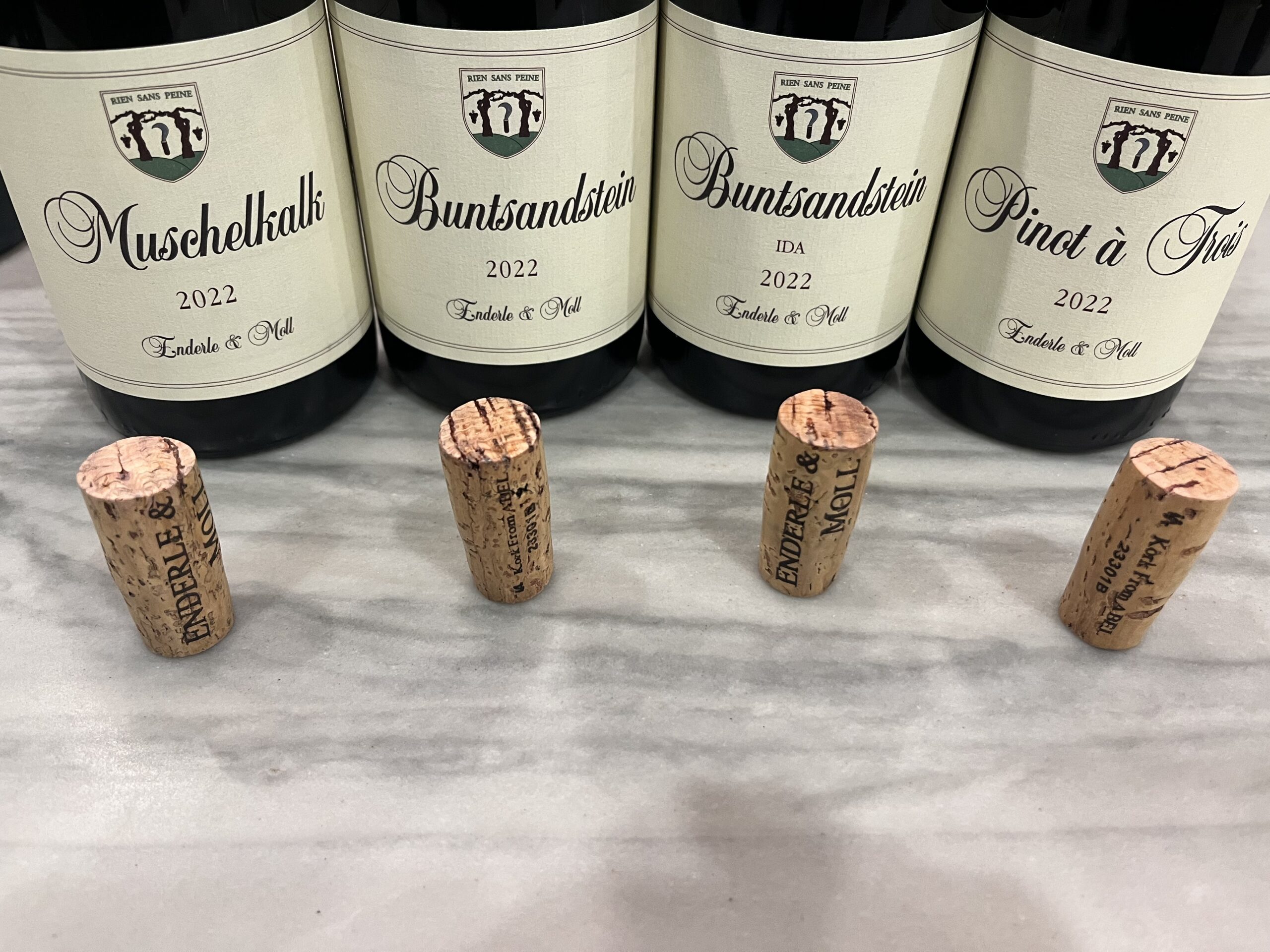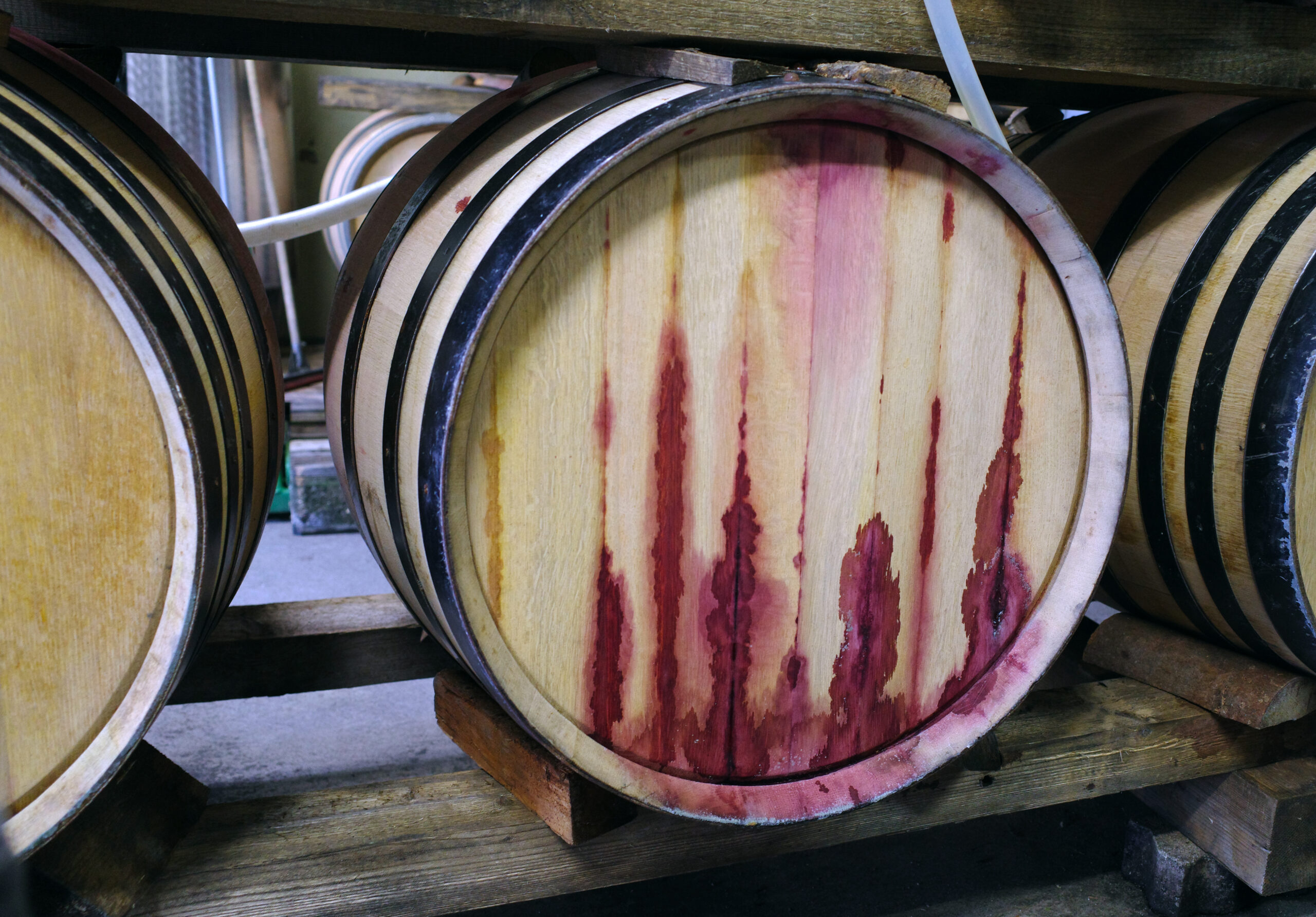The wines of Enderle & Moll were nothing short of a revelation when I first tasted them in 2008 or 2009 in New York. For me, having extensively tasted nearly all of “the best” Pinot Noirs that Germany was making, when I tasted Enderle & Moll the needle jumped the groove and the music stopped; the mic dropped.
Enderle & Moll had found the path, the way forward.
I think back to the early 2000s, to years of tasting German Spätburgunders with great curiosity (and, it must be said, most often with much disappointment). Enderle & Moll was the first estate I tasted that so clearly offered the counter-narrative to what most red wine (including Pinot Noir) was at that moment.
In a world that valued dense color, extraction and voluminous textures, Enderle & Moll’s Pinots were alarmingly light in color (“chillable reds” 15 years before that genre arrived), unquestionably light, often times angular and structured.
In a world that valued fruit, Enderle & Moll delivered soil tones and wines with a perfect sense of balance.
When most growers in Germany hadn’t really heard of natural wine, or had nonchalantly dismissed it, Enderle & Moll quickly and instinctually found the value and insight to be had here, pulling from this cultural bag many of the ideas that are now unquestionably accepted by even the most “classic” of contemporary winegrowers: a focus on selection massale, vine age, organic or at least very thoughtful farming, a more delicate élevage, a more considered curation of quality barrels, often used, often from Burgundy, bottling unfined and unfiltered when possible.
In a German Spätburgunder world that still seemed to focus on ripeness above all, on late-harvesting (“Spätburgunder Auslese Trocken” if you will) to produce the biggest wines, Enderle & Moll focused on the quality of the site and didn’t seem to care at all about the potential alcohol.
 Here was the path forward for German Spätburgunder and the extraordinary – the profound – leaps and bounds that German Spätburgunder has made in the last 15+ years (in Baden and beyond) is largely built on the foundation that Enderle & Moll laid.
Here was the path forward for German Spätburgunder and the extraordinary – the profound – leaps and bounds that German Spätburgunder has made in the last 15+ years (in Baden and beyond) is largely built on the foundation that Enderle & Moll laid.
Now, I’m not saying that all German growers looked to Enderle & Moll as their inspiration; many German growers have found a similar place, a similar style, without knowing much or anything about Enderle & Moll. I’m not a winemaker; I don’t live in Germany. I can’t honestly speak of how influential they were. It should be said also that much about this movement in German Pinot Noir was “in the air” as one might say – it was the Zeitgeist.
What I am saying, however, is that Enderle & Moll seems to have found this place, this style, very early on. And it’s worth remembering that they did so at a time when it was not obvious nor easy to focus on wines of soil and delicacy.
Today everyone you speak with will talk about delicacy and soil, they will talk about having no interest in new wood. Yet Enderle & Moll flew this flag nearly two decades ago, even in the face of sharp headwinds at the beginning.
For this Enderle & Moll deserves a rather hallowed place in the story of German Pinot Noir. To some degree, it is as simple as that.
The fact that their wines are, nearly twenty years later, still among the most clear and transparent, the most soil-driven, the most unique Pinots made in Germany only adds to this legacy. Many things have changed at this estate; Florian Moll’s initial partner Sven Enderle has since left the estate (bizarrely, another Enderle, not related, remains at the estate), yet the feel, the philosophy, the integrity, the very specific quality of the estate and what they do has not changed.
Yet I think this last point, this very specific quality, this uniqueness, has also hurt the wines in the marketplace. There is no denying the wines are expressive of vintage (lean and sinewy in 2021, more textural and plush in 2022), they are ruthlessly soil driven, they can be wild. Enderle & Moll has a style that will not appeal to all, but it will appeal to many.
And to some, the wines will be a revelation.
In our Instagram-driven world of “the new new,” of a style-curation that is driven by “the most acceptable to the greatest numbers,” unique voices like Enderle & Moll are overlooked, by design! To say nothing of our myopic obsession with the least-available, with the almighty algorithm pointing us all toward the one bottle we cannot find and must pay 100x what we should to acquire. Everything else seems be get lost in the hazy, fuzzy periphery.
Could it be the greatest liability of Enderle & Moll is that they are both singular and canonical, they are available, and they are fairly priced? They occupy a realm not unlike Clos Roche Blanche back in the day, the wines which I would nonchalantly buy over and over again without a thought about “collecting” or “aging” or any sort of speculation. They were simply wines to open and to enjoy; they were thrillingly honest, delicious. They had soul and character.
In our new world, these qualities seem to be no challenge to the new, the rare, the expensive. It’s sad to say, but it’s not even a fair fight right now.
For the love of humanity, in the name of quirkiness, for the sake of personal curation and style, please focus on the periphery – deny the algorithm.
Go find these wines; try them – tell us what you think: orders@vomboden.com
Here is a quick overview of what’s in the market.

2021 Enderle & Moll Pinot Noir
The so-called entry-level Enderle & Moll Pinot is lovingly called “Basis,” though in many cases the label says nothing, just “Pinot Noir.” The wine is sourced from 30-year-old vines planted on the two predominant soil types in Baden: colored sandstone and shell limestone. This is always a sinewy, energetic wine. In the 2021 vintage the palate has a sharp snap of cherry and cranberry piquancy along with mild tannins.
2021 Enderle & Moll Pinot Noir “Liaison”
The “Liaison” is something like Enderle & Moll’s “1er Cru” bottling, from vines 50 years old and older (what a country due west might call Vieilles-Vignes) planted on the two predominant soil types down here in Baden: colored sandstone and shell limestone. A “Liaison” of soil types if you will. It is always one of the most compelling Pinots out there, an absurd value that easily out-classes wines that are twice the price. Ruby and vibrant in the glass – this is unmistakably PURE Pinot. On the palate the wine is very fine and delineated, deeply soil driven. The tannins are woven and very much in focus, fruit is more purple and blue than that of Basis’s pure red and the wine just so obviously overdelivers it is more than a touch absurd.
While the two wines above make up the majority of Enderle & Moll’s Pinot program, the 2022 Grand Crus of Enderle & Moll have arrived; there are four in 2022, collect them all?
2022 Enderle & Moll Pinot Noir “Buntsandstein” Grand Cru
The Buntsandstein, or colored sandstone, is sourced from prime parcels of vines around 60 years old. Normally the Pinots from sandstone are more lavish, aromatic and generous – yet in 2022 the Buntsandstein is sharper, more red-fruited and tightly wound up. It is distinctly spicy, with a sappy, green pine-needle edging to it that balances the mouthwatering fruit and seems to introduce a very prominent minerality. The tannic structure is very sandstone, with a granular sandy and gripping force to it. In fact, while the Muschelkalk tends to be the most structured, with vintage 2022 the Buntsandstein might be more of the fortress. This clocks in at 12.5%.
2022 Enderle & Moll Pinot Noir “Buntsandstein Ida” Grand Cru
The “Ida” is sourced from a tiny colored-sandstone parcel in the same general vicinity as the regular Buntsandstein. The parcel was given to them by an older lady named Ida who had farmed the parcel for decades. When they first made the wine, presumably they intended to increase their Buntsandstein production, yet they noticed immediately that the wine just tasted different. The “Ida” is normally denser, darker, more earthy and brooding – and so they began to bottle it separately. The 2022 Ida lives up to the reputation; this flaunts more of the inky, blackberry-fruited depth of the Muschelkalk, yet it is more expansive and silken, with a dark minerality and sappy notes, rocks and a salty umami undertone. This has a similar structure to the regular Buntsandstein, yet it feels a bit more wound up, tighter, more structured. It is truly superb in 2022.
2022 Enderle & Moll Pinot Noir “Muschelkalk” Grand Cru
The “Muschelkalk,” meaning shell limestone in German, is from their oldest Pinot Noir vines planted in the early 1950’s – so 70+ years old – and thought to be the oldest in the area. While this is nearly always the lightest and most structured of the E&M Pinots, in 2022 this is perhaps the most seductive and deep-fruited I’ve ever tasted. The palate is awash with black cherry, blackberry finely woven around leather, dried herbs, sap and forest notes. The lush and coating palate is brought into focus by a persistent acidity and an ultra-fine tannic grip, that’s almost surprising given the suave beginning. This is deep, deep, deep – it clocks in at 13% – yet feels neither hot nor heavy.
2022 Enderle & Moll Pinot Noir “Pinot a Trois” Grand Cru
Sourced from the best barrels from each of the three “Grand Crus,” the Pinot a Trois is only made when they think it should happen – this is art more than science. For 2022, this is the leanest this wine has ever been. Normally the most fleshy and ripe, in 2022 it is the most focused (clocking in at only 12%). While it is dark-fruited like the Buntsandsteins, it feels more tightly-wound and inward-looking; the nose is muted. While it has a touch of the wild, the sous bois common to E&M, the overall effect is more crushed mineral, a dark almost iron-ore type minerality. On the palate the dark fruit rises into bright flashes of red fruit, an almost unexpected energy. The wine is short and punchy right now, yet dense and coating – this is wound up and energetic, with great structured and possibly a storied future ahead of it… for the few who can find the wine.
